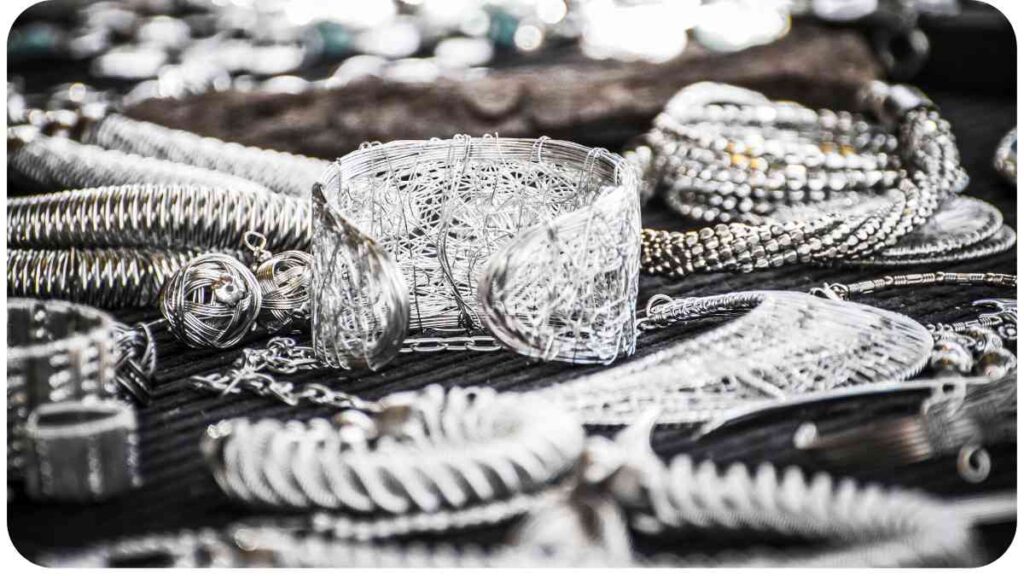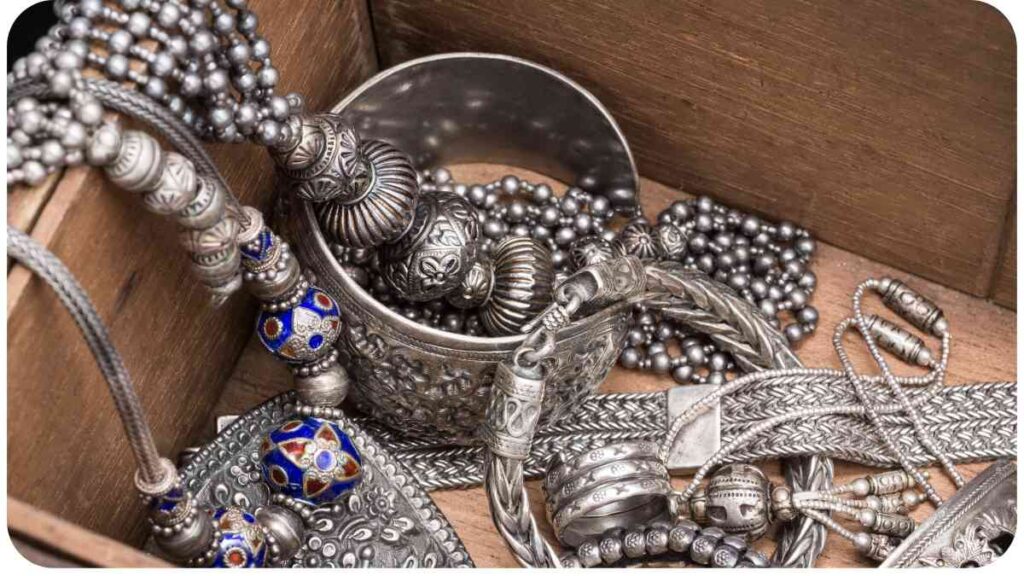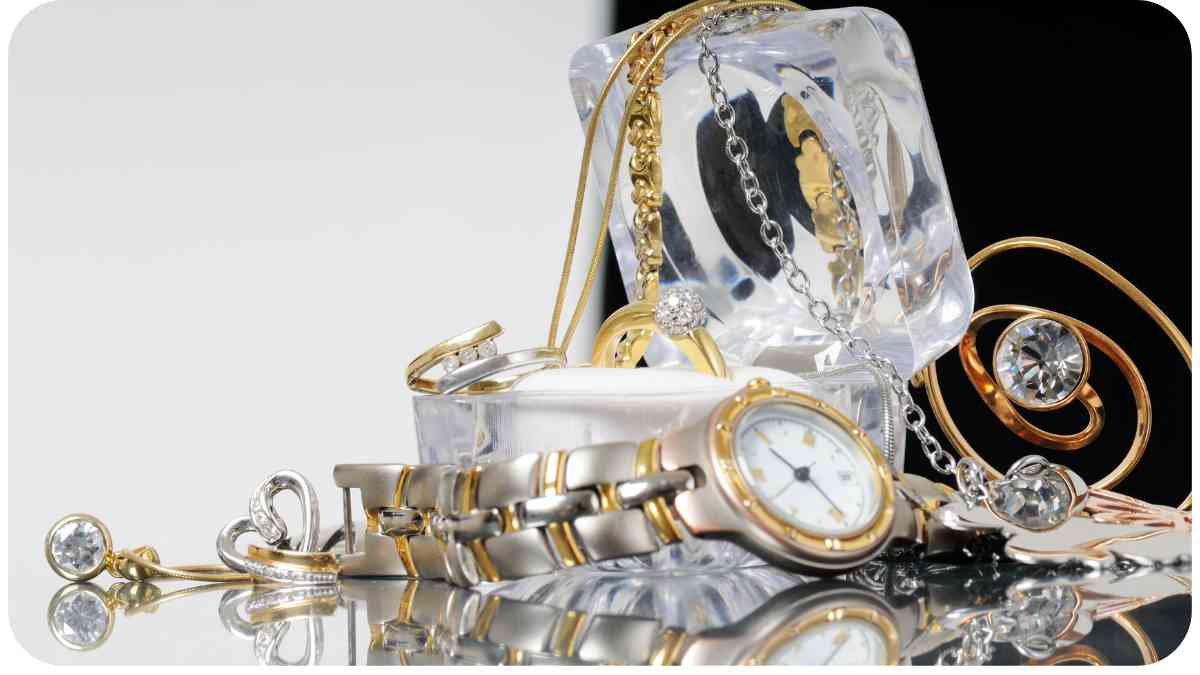Welcome to our comprehensive guide on why your silver jewelry turns black. As an experienced and knowledgeable content writer in the field of jewelry, I will provide you with valuable insights, tips, and techniques to understand the science behind tarnishing and offer practical solutions to keep your silver jewelry looking shiny and beautiful.
| Takeaways |
|---|
| – Tarnish on silver jewelry is a natural process caused by various factors like sulfur, moisture, and chemicals in the environment. |
| – Proper storage of silver jewelry in tarnish-resistant containers helps prevent tarnish formation. |
| – Avoiding contact with substances like perfumes, lotions, and hairsprays can reduce the likelihood of tarnish. |
| – Regular cleaning and maintenance of silver jewelry can help slow down tarnish formation. |
| – Home remedies like baking soda, lemon juice, and toothpaste can be effective in removing tarnish. |
| – Professional cleaning methods, such as ultrasonic cleaning or steam cleaning, may be necessary for heavily tarnished or delicate pieces |
2. Understanding the Science Behind Tarnishing
Before we dive into preventive measures and cleaning techniques, it’s essential to understand why your silver jewelry tarnishes over time. Silver reacts with various elements present in the environment, causing it to develop a dark, blackish layer known as tarnish. This tarnish can diminish the appearance of your jewelry and affect its overall value.
When it comes to jewelry care, proper sunscreen application tips and tricks can indirectly impact tarnish prevention. Shielding your skin from harmful UV rays while avoiding contact with silver jewelry is a smart move.
3. Factors Contributing to Silver Tarnish

Several factors contribute to the tarnishing of your silver jewelry. Let’s explore these factors in detail and understand how they affect the shine and longevity of your precious pieces.
Presence of Sulfur Compounds
Sulfur compounds found in the atmosphere, such as hydrogen sulfide, can react with the silver surface and accelerate tarnishing. These compounds are commonly present in polluted air, industrial areas, and areas with high sulfur content.
Table: Common Sources of Sulfur Compounds
| Source | Description |
| Air pollution | Industrial emissions, vehicle exhaust, and combustion processes |
| Household chemicals | Cleaning agents, gas leaks |
| Swimming pools | Chlorine compounds used for water treatment |
| Certain foods | Eggs, onions, and foods high in sulfur content |
| Personal care products | Cosmetics, fragrances, and hair products |
| Water supply treatments | Some water sources may contain sulfur compounds |
Humidity and Moisture
High humidity and moisture levels contribute to the oxidation of silver, leading to tarnishing. When your jewelry is exposed to a humid environment, the moisture in the air reacts with the silver surface, forming silver sulfide, which gives the jewelry a blackish appearance.
Understanding the causes and remedies for hair fall hair care is essential, but did you know that hair products and routines can affect your jewelry too? Learn how to maintain your hair and jewelry simultaneously.
Table: Impact of Humidity Levels on Silver Tarnish
| Humidity Level | Tarnish Intensity |
| Low (25-35%) | Minimal tarnishing, slower rate of tarnish buildup |
| Moderate (35-55%) | Steady tarnish buildup |
| High (>55%) | Rapid tarnishing, accelerated tarnish formation |
Air Pollutants and Chemicals
Certain air pollutants and chemicals, such as ozone, sulfur dioxide, and hydrogen peroxide, can react with the silver surface and expedite tarnishing. Exposure to these pollutants and chemicals can be more pronounced in urban areas or environments with industrial activity.
Table: Common Air Pollutants and Chemicals Affecting Silver
| Substance | Presence |
| Ozone | Commonly found in outdoor air pollution, particularly cities |
| Sulfur dioxide | Emitted from industrial processes and burning fossil fuels |
| Hydrogen peroxide | Present in cleaning agents and hair dyes |
| Ammonia | Found in certain cleaning agents and household products |
Contact with Certain Sub
Certain substances can accelerate silver tarnish due to their chemical composition. When silver jewelry comes into contact with these substances, it undergoes chemical reactions that lead to tarnishing. Here are some common culprits:
Have you ever wondered why your earrings turn green? Jewelry tarnish is a common issue. This guide will help you understand the reasons behind it and how to prevent tarnishing in your precious jewelry.
Table: Substances that Accelerate Silver Tarnish
| Substance | Effects on Silver Jewelry |
| Perfume and Lotions | The chemicals present in perfumes and lotions can react with silver and tarnish it. |
| Sweat and Body Oils | Sweat and body oils contain compounds that can accelerate tarnishing. |
| Chlorine and Salts | Swimming pools and hot tubs containing chlorine or salt water can tarnish silver. |
| Rubber and Latex | Rubber bands, latex gloves, and elastic hair ties contain sulfur compounds that tarnish silver. |
| Detergents and Soaps | Certain detergents and soaps contain chemicals that can tarnish silver. |
4. Preventive Measures to Keep Your Silver Jewelry Shiny

Taking proactive steps to prevent tarnishing is crucial in maintaining the shine and appearance of your silver jewelry. Let’s explore some effective preventive measures you can implement.
Proper Storage and Maintenance
Storing your silver jewelry in airtight, tarnish-resistant containers can significantly reduce its exposure to tarnish-inducing elements. You can use anti-tarnish bags or tarnish-resistant fabric-lined jewelry boxes to keep your jewelry safe and secure.
Table: Storage Tips to Prevent Silver Tarnish
| Tip | Explanation |
| Store each piece of jewelry separately | Prevents scratching and reduces contact with other metals or substances. |
| Keep jewelry away from sunlight and direct heat | Exposure to light and heat can accelerate tarnishing. |
| Add moisture-absorbing packets or silica gel | Helps control humidity levels within the storage container. |
| Avoid storing silver jewelry in plastic bags | Plastic can trap moisture and speed up tarnish formation. |
| Consider using tarnish-resistant storage options | Anti-tarnish bags or fabric-lined jewelry boxes offer extra protection. |
Cleaning and Polishing Techniques
Regular cleaning and polishing can help remove tarnish and restore the shine of your silver jewelry. However, it’s important to use gentle techniques to avoid damaging the pieces.
Proper storage is key to preserving luxury handbags. Storage guide will not only help your bags but also your valuable jewelry. Discover the best practices to keep your luxury items in top condition.
Table: Cleaning Techniques for Silver Jewelry
| Technique | Process and Recommended Frequency |
| Gentle wiping with a soft cloth | Removes dirt and oils. |
| Mild soap and lukewarm water | Soak briefly, gently scrub, and rinse with water. |
| Table | Recommended Frequency for Cleaning |
| Ultrasonic cleaning | Every 6-12 months or as needed for heavily tarnished pieces. |
| Professional steam cleaning | Every 6 months or as recommended by a jeweler. |
Protective Coatings and Wraps
Applying protective coatings or wraps to your silver jewelry can create a barrier that slows down tarnish formation. Consider using products like silver dips, polishing cloths, or anti-tarnish solutions to provide an added layer of protection.
Table: Products for Protecting Silver Jewelry
| Product | Description |
| Silver dips | Immersion solution that removes tarnish and leaves a protective coating. |
| Polishing cloths | Treated cloths that remove tarnish and polish silver jewelry. |
| Anti-tarnish solutions | Sprays or dips that create a protective barrier against tarnish. |
| Table | Recommended Application Frequency |
| Coating with clear nail polish | Once every 2 months or as needed to maintain the protective barrier. |
| Wrapping jewelry in anti-tarnish paper | When storing jewelry for extended periods or traveling. |
| Storing with activated charcoal | Charcoal absorbs moisture and reduces tarnish-inducing elements in the air. |
Avoiding Contact with Damaging Substances
Limiting exposure to substances that accelerate tarnishing can help preserve the shine and appearance of your silver jewelry.
Table: Substances to Avoid Contact with Silver Jewelry
| Substance | Explanation |
| Perfume, lotions, and hairspray | Apply these products before wearing your silver jewelry to prevent contact. |
| Chlorinated water and saltwater | Remove silver jewelry before swimming or engaging in activities with exposure to these substances. |
| Household chemicals and cleaning agents | Avoid wearing silver jewelry while using such chemicals to prevent tarnish. |
| Table | Additional Recommendations |
| Take off jewelry during strenuous activities | Minimizes exposure to sweat and friction that can cause damage and tarnish. |
Put jewelry on after applying makeup and cosmetics | Reduces the likelihood of contact with substances that can tarnish silver. |
5. Home Remedies for Cleaning Tarnished Silver Jewelry
If your silver jewelry has already tarnished, there are several home remedies that can effectively remove tarnish and restore its shine. These methods are easy to implement and use household items.
Can heat affect your fragrances? Explore the impact of temperature on scents. Fragrance preservation is crucial, just as it is for certain types of jewelry. Learn how to protect your fragrance collection and your jewelry from environmental factors.
Baking Soda and Aluminum Foil Method
Using baking soda and aluminum foil creates a chemical reaction that helps remove tarnish from silver jewelry.
Table: Baking Soda and Aluminum Foil Cleaning Method
| Steps | Explanation |
| Line a bowl or container with aluminum foil | This creates a chemical reaction with baking soda to remove tarnish. |
| Fill the container with hot water | Hot water aids in the cleaning process and helps loosen tarnish. |
| Add a tablespoon of baking soda to the water | Baking soda acts as a cleaning agent and reacts with tarnish. |
| Place tarnished silver jewelry in the solution | Ensure the jewelry is in direct contact with the aluminum foil. |
| Let the jewelry soak for a few minutes | Allow the chemical reaction to dissolve the tarnish. |
| Rinse and dry the jewelry thoroughly | Rinse with clean water and dry with a soft cloth. |
| Table | Recommended Frequency |
| Repeat every few months or as needed for heavily tarnished pieces | Regular use helps maintain a clean appearance for your silver jewelry. |
Lemon Juice and Salt Solution
A mixture of lemon juice and salt acts as an effective cleaning agent for tarnished silver jewelry.
Table: Lemon Juice and Salt Cleaning Method
| Steps | Explanation |
| Squeeze fresh lemon juice into a bowl | Lemon juice contains citric acid, which helps remove tarnish. |
| Add a teaspoon of salt to the lemon juice | Salt acts as an abrasive to aid in the cleaning process. |
| Stir the mixture until the salt dissolves | Ensure the salt is fully dissolved for an effective solution. |
| Immerse the tarnished jewelry and let it sit for a few minutes | Allow the solution to penetrate and loosen the tarnish. |
| Rinse the jewelry under running water and dry thoroughly | Remove any residue from the solution and dry carefully. |
| Table | Recommended Frequency |
| Use every few months or as needed for mildly tarnished pieces | Regular use prevents the buildup of tarnish and maintains shine. |
Toothpaste Technique
Toothpaste can serve as a gentle abrasive to remove tarnish from silver jewelry.
Table: Toothpaste Cleaning Method
| Steps | Explanation |
| Apply a small amount of non-gel toothpaste to a soft cloth | Avoid using toothpaste with harsh abrasives or whitening properties. |
| Gently rub the toothpaste onto the tarnished areas | Use circular motions to work the toothpaste into the tarnished silver. |
| Rinse the jewelry under warm water and dry thoroughly | Remove any residue from the toothpaste and dry with a soft cloth. |
| Table | Recommended Frequency |
| Use every few months or as needed for mildly tarnished pieces | Regular use helps maintain a clean appearance for your silver jewelry. |
Hot Water and Dish Soap Soak
A simple hot water and dish soap soak can effectively remove tarnish from silver jewelry.
Table: Hot Water and Dish Soap Cleaning Method
| Steps | Explanation |
| Fill a bowl with hot water | Hot water aids in loosening tarnish and facilitates cleaning. |
| Add a few drops of mild dish soap to the water | Dish soap helps break down oils and removes dirt and tarnish. |
| Immerse the tarnished jewelry and let it soak for a few minutes | Allow the solution to remove tarnish and dirt from the jewelry. |
| Gently scrub the jewelry with a soft toothbrush | Use a soft toothbrush to remove any stubborn tarnish or dirt. |
| Rinse under warm water and dry thoroughly | Remove any soap residue and dry the jewelry gently. |
| Table | Recommended Frequency |
| Use every few months or as needed for mildly tarnished pieces | Regular use maintains the cleanliness and shine of your silver jewelry. |
6. Professional Cleaning Options
In certain cases, professional cleaning may be necessary to restore heavily tarnished or delicate silver jewelry. There are various professional cleaning methods available.
Ultrasonic Cleaning
Ultrasonic cleaning is a method that utilizes high-frequency sound waves to create vibrations that remove tarnish and dirt from the surface of silver jewelry. This cleaning method is often used by professional jewelers and can effectively restore heavily tarnished pieces.
During ultrasonic cleaning, the jewelry is submerged in a tank filled with a cleaning solution and placed in an ultrasonic cleaner. The cleaner emits high-frequency sound waves that create tiny bubbles in the solution. The bubbles explode upon contact with the jewelry, removing dirt and tarnish from hard-to-reach areas.
It’s important to note that not all types of silver jewelry are suitable for ultrasonic cleaning. Delicate or fragile pieces, jewelry with gemstones or pearls, and items with loose settings may be too sensitive for this cleaning method. Always consult a professional jeweler to determine if ultrasonic cleaning is appropriate for your specific piece.
Professional Steam Cleaning
Professional steam cleaning utilizes the power of steam to remove dirt, oils, and tarnish from silver jewelry. This method is usually carried out by jewelers using specialized equipment.
During the steam cleaning process, high-pressure steam is directed at the jewelry, loosening and flushing away dirt and tarnish. Professional steam cleaning can effectively restore the shine and luster of silver jewelry, making it look as good as new.
Similar to ultrasonic cleaning, it’s important to consult a professional jeweler to ensure that steam cleaning is suitable for your specific piece of silver jewelry.
Conclusion
Tarnish is a natural process that occurs on silver jewelry over time due to exposure to various substances and environmental factors. Preventive measures such as proper storage, regular cleaning, and avoiding contact with tarnish-inducing substances can significantly reduce tarnish formation.
In cases where tarnish has already formed, you can use home remedies like baking soda and aluminum foil, lemon juice and salt, toothpaste, or hot water and dish soap to effectively clean your silver jewelry. For heavily tarnished or delicate pieces, professional cleaning methods like ultrasonic cleaning or steam cleaning can be beneficial.
By implementing these preventive measures and utilizing appropriate cleaning techniques, you can maintain the shine and beauty of your silver jewelry for years to come.
Further Reading
Here are some additional resources that provide more information on why silver jewelry turns black and how to prevent and address tarnish:
- Why Has My Silver Jewellery Turned Black? – jewellerybox.co.uk
This blog post explains the common causes of silver jewelry tarnish and provides tips on preventing and removing tarnish. - Why Does Silver Turn Black or Green? – inesbouwen.com
Explore the science behind silver tarnish and learn about different factors that contribute to the discoloration of silver jewelry. - Silver Necklace Turning Black: Causes and Solutions – allthingsjewelryy.com
This article specifically focuses on silver necklaces and offers insights into the reasons behind tarnish formation and how to tackle the issue.
FAQs
Here are some frequently asked questions (FAQs) and answers regarding silver jewelry tarnish:
Q: Can I prevent silver jewelry from tarnishing?
A: Yes, you can take preventive measures such as storing your jewelry properly, avoiding contact with tarnish-inducing substances, and regular cleaning and maintenance.
Q: Why does silver jewelry tarnish over time?
A: Silver tarnish occurs due to chemical reactions with substances like sulfur, moisture, and certain chemicals present in the environment.
Q: How can I remove tarnish from my silver jewelry?
A: You can use various home remedies like baking soda, lemon juice, or toothpaste for mild tarnish. For heavily tarnished or delicate pieces, it’s advisable to seek professional cleaning.
Q: What type of storage is best for preventing silver tarnish?
A: Tarnish-resistant containers, such as anti-tarnish bags or fabric-lined jewelry boxes, offer the best protection for storing silver jewelry.
Q: Is it safe to use an ultrasonic cleaner on all types of silver jewelry?
A: Not all types of silver jewelry are suitable for ultrasonic cleaning. Delicate or fragile pieces, jewelry with gemstones or pearls, and items with loose settings may be too sensitive for this method. Consult a professional jeweler for guidance.

Hi, you! I’m Hellen James. I’m a beauty and fashion writer who loves to make the world a little more stylish and I’d love for you to join me in the fun! I’ve been writing about beauty and fashion since I was a kid, but it wasn’t until recently that I really knew what it meant to be a real expert.

